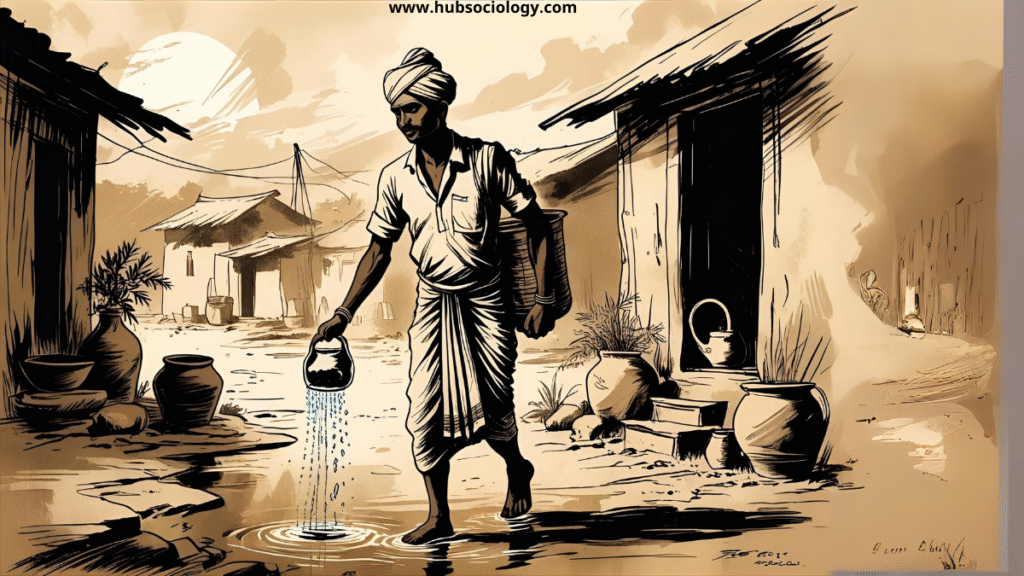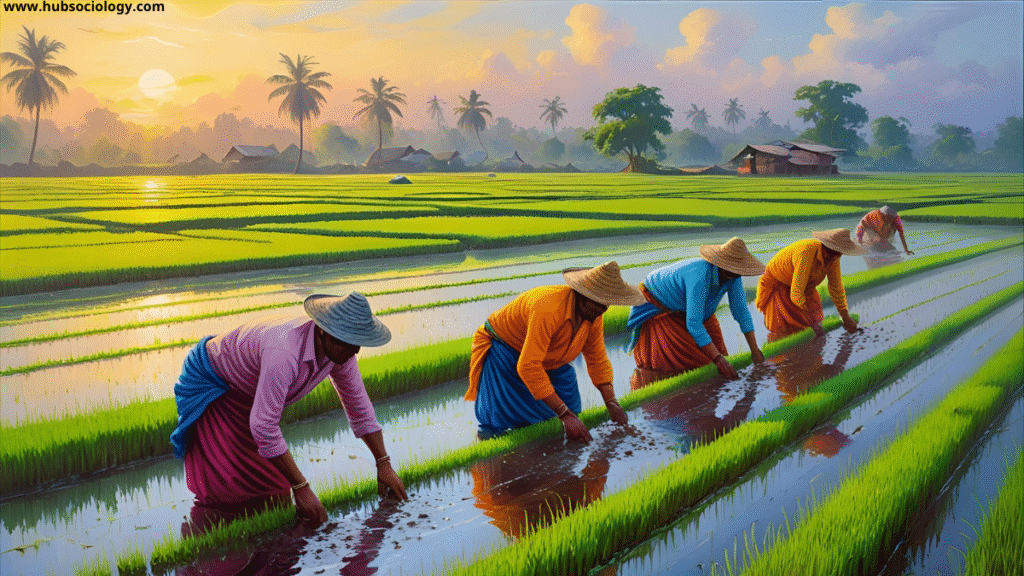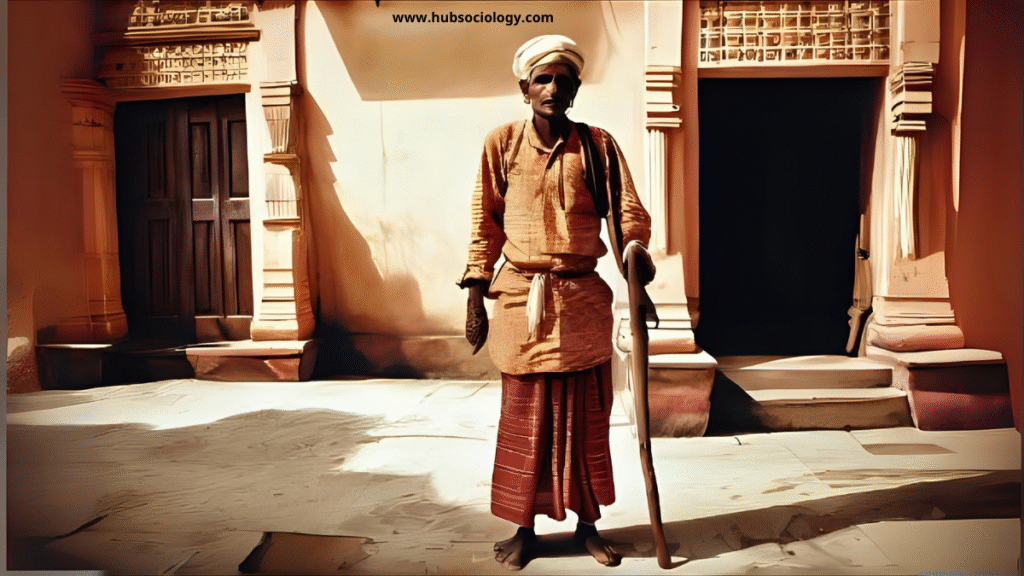Introduction
The Jajmani system was a traditional socio-economic arrangement in rural India that governed the exchange of goods and services among different castes. It was a reciprocal relationship between the landowning upper castes (Jajmans) and the service-providing lower castes (Kamins). This system, deeply rooted in the caste hierarchy, played a crucial role in maintaining social order and economic stability in pre-modern Indian villages. However, with the advent of modernization, urbanization, and economic reforms, the Jajmani system has significantly declined. This article explores the origin, functions, and decline of the Jajmani system from a sociological perspective.

Origin of the Jajmani System
The term “Jajmani” is derived from the Sanskrit word Yajman, meaning a patron or sacrificer, indicating the ritualistic and hierarchical nature of the system. The Jajmani system can be traced back to ancient India, where the caste system (Varna and Jati) structured society into hereditary occupational groups.
Historical Context
- The system was deeply embedded in the agrarian economy, where landowning castes (Brahmins, Kshatriyas, and Vaishyas) held economic and social dominance.
- The lower castes (Shudras and Dalits) provided specialized services such as pottery, blacksmithing, weaving, and scavenging in exchange for grain, clothing, and other necessities.
- The system was reinforced by religious sanctions, with the Dharmashastras legitimizing caste-based division of labor.
Structural Features
- Hereditary Obligations: Occupations were passed down through generations, binding families to their traditional roles.
- Reciprocity: The exchange was not purely economic but also social and ritualistic.
- Patron-Client Relationship: The Jajman (patron) provided protection and sustenance, while the Kamins (service providers) offered loyalty and labor.
Functions of the Jajmani System
From a functionalist perspective, the Jajmani system maintained social cohesion and economic interdependence in rural India.
1. Economic Functions
- Subsistence Economy: The system ensured that all village needs were met without reliance on external markets.
- Barter System: Payments were made in kind (grains, clothes, shelter) rather than cash, sustaining self-sufficient villages.
- Occupational Security: Each caste had a fixed role, ensuring employment and economic stability.

2. Social Functions
- Caste Reinforcement: The system perpetuated caste hierarchies by assigning specific roles to each group.
- Social Control: The upper castes maintained dominance, while the lower castes remained subservient.
- Community Solidarity: Despite inequalities, mutual dependence fostered a sense of collective identity.
3. Ritualistic Functions
- Religious Sanctions: The Brahmins performed rituals for the Jajmans, reinforcing their spiritual authority.
- Festivals and Ceremonies: Service castes played essential roles in weddings, funerals, and festivals, strengthening social bonds.
Decline of the Jajmani System
The Jajmani system began disintegrating due to various socio-economic and political changes in the 19th and 20th centuries.
1. British Colonialism and Land Reforms
- The British introduced cash-based revenue systems (Permanent Settlement, Ryotwari), disrupting traditional barter exchanges.
- Land became a marketable commodity, weakening hereditary patron-client ties.
- Commercialization of agriculture reduced dependence on village artisans.
2. Industrialization and Urbanization
- Factories and urban jobs provided alternative livelihoods, reducing reliance on caste-based occupations.
- Mass-produced goods replaced handmade products, making traditional artisans obsolete.
3. Social Reform Movements
- Movements led by Jyotiba Phule, B.R. Ambedkar, and Gandhi challenged caste oppression.
- Education and legal reforms (abolition of untouchability, reservation policies) empowered lower castes to seek better opportunities.
4. Market Economy and Globalization
- The cash economy replaced the barter system, making traditional exchanges irrelevant.
- Globalization introduced new occupations, breaking caste-based occupational rigidity.
5. Political and Legal Changes
- Democratic governance and land redistribution policies weakened the dominance of upper-caste landlords.
- Labor laws and minimum wage policies provided better bargaining power to service castes.
Sociological Perspectives on the Decline
Functionalist View
- The decline was inevitable as modernization required more flexible economic structures.
- New institutions (banks, markets, industries) replaced traditional systems for greater efficiency.
Conflict Theory Perspective
- The Jajmani system was exploitative, maintaining caste oppression.
- Its decline represents the empowerment of marginalized groups challenging Brahmanical dominance.
Weberian Analysis
- Rationalization and bureaucratization eroded traditional authority.
- Capitalism introduced merit-based roles over hereditary occupations.
Contemporary Relevance and Legacy
While the Jajmani system has largely disappeared, its remnants persist in some rural areas.
- Informal Jajmani Ties: In remote villages, some traditional exchanges continue.
- Caste-Based Discrimination: Despite legal abolition, caste influences modern employment and social relations.
- Cultural Memory: Folklore and rituals still reflect Jajmani relationships.
Conclusion
The Jajmani system was a complex web of economic, social, and ritualistic exchanges that sustained rural India for centuries. While it provided stability, it also reinforced caste hierarchies and exploitation. Its decline was a result of colonial policies, industrialization, social reforms, and globalization. From a sociological standpoint, the transition reflects broader shifts from traditional to modern economies, from caste-based to class-based stratification. Though the system has faded, understanding its legacy helps analyze contemporary caste dynamics in Indian society.

Do you like this this Article ? You Can follow as on :-
Facebook – https://www.facebook.com/hubsociology
Whatsapp Channel – https://whatsapp.com/channel/0029Vb6D8vGKWEKpJpu5QP0O
Gmail – hubsociology@gmail.com
Topic Related Questions
5-Mark Questions (Short Answer Type)
- Define the Jajmani system in rural India.
- What were the two main groups involved in the Jajmani system?
- Name any three traditional occupations under the Jajmani system.
- How did the British land revenue policies affect the Jajmani system?
- What role did caste play in the Jajmani system?
- How was payment made in the Jajmani system?
- Give two reasons for the decline of the Jajmani system.
- What was the role of Brahmins in the Jajmani system?
- How did industrialization impact the Jajmani system?
- What is the meaning of the term ‘Jajman’ and ‘Kamin’?
10-Mark Questions (Descriptive Answer Type)
- Explain the origin and structure of the Jajmani system in India.
- Discuss the economic functions of the Jajmani system in rural society.
- How did the Jajmani system reinforce caste hierarchy in villages?
- Analyze the impact of British colonialism on Jajmani system.
- Describe the patron-client relationship in Jajmani system.
- What were the social and ritualistic functions of Jajmani system?
- How did social reform movements contribute to the decline of Jajmani system?
- Compare Jajmani system with modern market-based economies.
- Explain the role of artisans and service castes in Jajmani system.
- How has globalization affected traditional systems like Jajmani?
15-Mark Questions (Long Essay Type)
- Critically examine Jajmani system, its features, and its impact on rural Indian society.
- Discuss the factors responsible for the decline of Jajmani system in post-independence India.
- Evaluate Jajmani system from a functionalist and conflict theory perspective.
- How did Jajmani system maintain social order in traditional Indian villages?
- “Jajmani system was exploitative yet functional.” Comment on this statement.
- Analyze the transition from Jajmani system to a market economy in rural India.
- What are the remnants of Jajmani system in contemporary Indian society?
- Compare Jajmani system with feudal systems in medieval Europe.
- How did land reforms and industrialization contribute to the disintegration of Jajmani system?
- Assess the role of caste in sustaining and later weakening Jajmani system.
